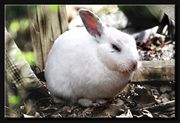Fluffy Bunnies as the saviours of infrastructure
When one thinks of fluffy bunnies, the general impression often is: "All right, I have nothing against those little rodents[1] - but are they good for anything except cuddling and eating, and perhaps huffing if there are no kittens about?" The simple fact about bunnies in general, and most importantly about fluffy bunnies, is that they are one of the most outstanding economic resources a geographical region can have.
The fluffiness and infrastructure[edit | edit source]
The fluffiness of fluffy bunnies seems like a secondary property, but it is in fact what makes fluffy bunnies what they are. Think of fluffy puppies, for instance: how many letters have been changed to transform a puppy into a bunny? The answer is simple: three letters. We also should not ignore the fact that out of those letters, in one of the words, puppy, all three are the same, namely the letter p. In the word bunny, only two of the letters are the same, as the critical reader must have noticed by now - but that is only coincidental, as we will go on to demonstrate!
To appreciate the minority of difference between a fluffy bunny and a fluffy puppy, the reader only needs to compare those to a fluffy kitten. How many letters have been changed there? Why, all of them! Now it can clearly be seen why we should not pick the difference between a puppy and a bunny to play such a big part in the conversation. Of course, there are other fluffy things that differ even more from bunnies. Take the Llama, for instance. Not only the name is totally different, but the animal itself is huge compared to a bunny.[2] If an area was infested by 1000 llamas compared to 1000 fluffy bunnies, what would be likely to happen? A total disaster. Ferocious llamas would skulk the streets by night, ready to squirt large amounts of spit into people's faces. What if there were 100 000 llamas? If this happened in central London or in Smörgården in Stockholm, for instance, the infrastructure would be ruined in days. Thus it is fairly easy to see why fluffy bunnies are preferable.[3]
The bunniness and infrastructure[edit | edit source]
Buns and bunnies have nothing in common on the surface. We might go as far as to claim they have nothing in common otherwise, either - but for a few things worth studying. These things can be broken down one by one for the reader to get a clear picture of the differences and similarities of these outwardly different entities[4].
The fluffiness of buns and bunnies compared[edit | edit source]
Buns and bunnies can both be fluffy. Bunnies are almost always fluffy, except when they are wet. Buns, however, are fluffy only if
- they have been covered with whipped cream, sugar, or the like, or
- they have been baked in such a way that the surface has been left porous and smooth. This is a rare feat and requires a master baker, of a kind that can only be found in the region of Amsterdam, Holland, and in some parts of Belgium. [5]
The atom structure of buns and bunnies; the impact on infrastructure thereof[edit | edit source]
Buns and bunnies are both carbon-based entities. Neither of them contains any carbon monoxide, however.[6] This is a very important little detail in our study. Carbon monoxide kills indirectly more than 150 000 people every week in factories, marketplaces, saunas, kotas, igloos, and cars. This figure alone is remarkable enough; we will not need to delve deeper into details. Suffocate it to say that if more bunnies were about, this would not happen - for the simple reason that bunnies can detect carbon monoxide at floor level by dying. No bun has ever prevented a carbon monoxide poisoning.[7] This should be a clear indication of the general usefulness of bunnies: imagine all of those dead people in the workforce today! The world, with all of its regions, would be ready by now.
General usefulness of fluffy bunnies[edit | edit source]
Fluffy bunnies build their labyrinthine homes by burrowing underground. This has a great and beneficial impact on the area they have settled on. First of all, many dangerous animals like the scrotum ferret[8] will not live in regions thus ventilated by bunnies. Scrotum ferrets prefer tight, claysome ground because their nails sink in softer grounds, making it harder for them to jump up and nibble at people's scrotums. Another great bonus about ventilated ground is that it will not need further ventilation, and flowers and trees manage far better, not to mention worms. Worms often use the tunnels made by bunnies, and therefore will not need to eat their way through the dirt any longer. This is a remarkable lessening to the workload of our tubular little friends[9].
| Area | Time span | Climate, other properties | Number of fluffy bunnies | Effect(s) of bunnies (or lack thereof) |
|---|---|---|---|---|
| Northern Norway | 5000 BC (approx.) - AD 2009 | Craggy, unsupporting landscape, mostly infested by lemmings. Winters too cold, summers too short. No trees! | Maybe a few | The only practicable professions in the area: reindeer herder, shaman, hooker. |
| Sahara | 5000 BC (approx.) - AD 2009 | Arid, sandy, unsupporting landscape, mostly populated by scorpions, disgusting spiders and poisonous snakes. Harsh, dry and hot climate. No trees - no vegetation at all, in fact! | None | No practicable professions available in the area. |
| England | 5000 BC (approx.) - AD 2009 | Alluvial climate, smooth and easily cultivated landscape. | Millions, perhaps tens of millions! | One of the world's leading economies and military and political powers, a leader of cultural life. Thousands of different professions available - including pimp. |
| Australia | 5000 BC (approx.) - AD 1859 | Different types of landscapes and climates - climates ranging from arid to alluvial. | None | Professions available: hunter, herder, gatherer, hooker, shaman, farmer, criminal. |
| Australia | AD 1859 - AD 2009 | Different types of landscapes and climates - climates ranging from arid to alluvial. | Hundreds, thousands, tens of thousands, HUNDREDS OF THOUSANDS, MILLIONS, HUNDREDS OF MILLIONS OR MORE!! | Growing (and in the latter part of the period, booming) economy, thousands of different professions available, the world's best Academy of fine arts as one outstanding result. |
If you study this table, you will immediately notice the positive effect fluffy bunnies can have on the economy of an area. Note how the increasing number of fluffy bunnies increased the number of available professions in Australia and drastically improved its economy and cultural life! Also note how even climate cannot compete with fluffy bunnies for effect.
Conclusion[edit | edit source]
While you may have arguments against letting fluffy bunnies burrow in your lawn, in the wider scheme they have been proven beneficial more often than harmful. Governments should hand out grants to those who are currently trying to make communities around the world more amenable towards fluffy bunnies. All evidence at hand speaks for such practice.
Footnotes[edit | edit source]
- ↑ Recent studies have shown that fluffy bunnies are not rodents. They are ruminants, as the Holy Bible states. A rodent is something vicious - how can such a cute, fluffy little animal be vicious?
- ↑ It must also be mentioned that llamas have been exiled from Tibet, where they used to be heads of important religious communities. Bunnies would never do that, I assure you.
- ↑ This doesn't in any way indicate that the fluffiness of llamas makes it OK for them to roam the streets during nights, squirting spit and trying to molest honest whores and pimps - not even in small numbers.
- ↑ If you count out the slight similarity of spelling, or the first part of it.
- ↑ There is a rumour that some bakers currently living and working in Paris can bake fluffy buns, but skepticism would not be grossly misdirected here.
- ↑ Except when a bunny has been smoked instead of grilled.
- ↑ If we count out the instances when choking on a bun has been the only alternative to a carbon monoxide poisoning.
- ↑ Frank Zappa: Ferrets nibbled my scrotum, 1972
- ↑ Contrary to a popular belief, most worms do not sting. Neither do they work for zombies.

